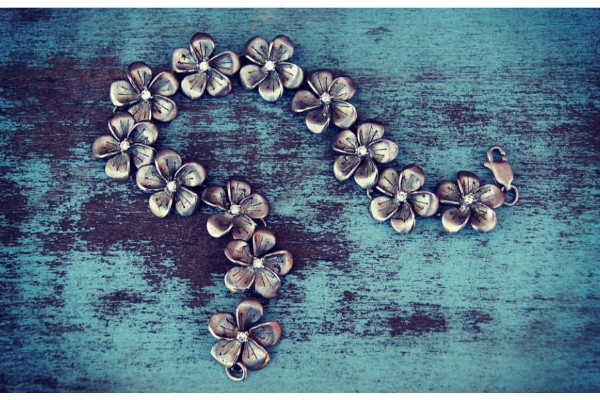The most frequent issue with fashion jewelry that has been stored away is that over time the metal is exposed to elements in the air which cause a chemical reaction, leaving them tarnished or discolored. There are a number of reasons why jewelry becomes dull or dirty (like water, creams, or lotions). Fortunately, it can be fixed quickly. Here are our top home remedies for polishing off any tarnish to give your favorite vintage jewelry pieces new life, whether they are earrings, a flashy necklace, or a bauble bracelet.
Table of Contents
What Leads To Jewelry Tarnishing?
When a piece of jewelry comes into contact with certain external elements like body oils, sulfur, sweat, makeup, and other cosmetics, a tarnish develops on the metal. You can choose a method to clean tarnished jewelry based on the degree of tarnish that has developed on your jewelry item. After a long day, your jewelry needs to be cleaned just like you do! There are a couple of different causes for jewelry to tarnish:
Abrasion
When cosmetics (like sunscreen) are used on jewelry, the metal can become abraded. makeup, perfumes, and lotions that are usually applied to the skin) comes into contact with the metal jewelry item. Chemical substances, such as titanium dioxide, zinc oxide, calamine, and ferric oxide) that is harder than the metal within the jewelry. Tiny metal particles—which resemble black dust—scratch off cosmetics and metal jewelry and land on absorbent surfaces like skin and clothing. It appears to be a black smear. Avoid using cosmetics containing the aforementioned chemical elements and always take off your jewelry before applying cosmetics to prevent this. Prior to putting on your jewelry, ensure that your skin is dry.
Corrosion
Corrosion of the metals used to make jewelry is another factor that can result in the discoloration of jewelry items. As an illustration, pure gold (i.e. 24K) will not corrode, but it is far too soft to actually form into a jewelry item. Because of this, pure gold needs to be alloyed with other base metals (such as silver or copper) to make it harder and more suitable for everyday use. It is the base metal, not the pure gold, that corrodes when jewelry items do.
Corrosion: How does it take place?
Moisture and wetness are conducive to corrosion. Numerous perspiration glands on our skin secrete fat and fatty acids. Copper or silver jewelry tends to corrode very quickly when perspiration, heat, and open-air are present. Additionally, touching salty foods with your hands can corrode and discolor your jewelry, leaving stains directly underneath where your jewelry items are.
Exposure to Air – Jewelry made of other metals has a lower resistance to tarnishing than sterling silver jewelry. Contact with sulfur compounds is typically to blame for the tarnish on sterling silver objects. The primary cause of tarnishing is hydrogen sulfide gas in the air, which is particularly present in foul-smelling pollution and foods like eggs, onions, and fish. Sterling silver jewelry often leaves green stains on the skin of those with particularly oily skin.
Dermatitis and Exposure to Other Elements – When other elements (such as soap, detergent, cosmetic creams, medications, antibiotics, or polish) build up between the jewelry item and the skin, dermatitis can occur. Dermatitis results in skin that is red and burning to the touch. You can avoid this by taking off all jewelry before using any of these products, cleaning your jewelry frequently, and waiting until your skin is completely dry before putting on any jewelry. In some cases, tarnishing is brought on by a person’s body chemistry reacting to the alloys in their jewelry. Wearing jewelry made of pure metals (such as platinum or gold) may be a solution to this problem. 18K or 22K gold jewelry instead of 14K).

How Often To Clean Tarnished Jewelry
Depending on the metal used, how it is stored, and how frequently it is worn, jewelry cleaning frequency varies. Other metals do not tarnish as quickly as silver, despite the fact that silver tarnishes easily. Any type of metal jewelry, however, can lose its shine from frequent wearing and handling.
Regularly worn jewelry needs to be cleaned at least once a month, and more frequently if the finish starts to look worn. If excessive dirt, grease, or harsh chemicals like chlorine bleach have been exposed to any type of metal jewelry, it should be cleaned right away.
How To Clean Tarnished Jewelry
Before You Begin
Try to identify the type of material used to create the piece before you clean any kind of jewelry. What metals—silver, pewter, stainless steel, copper, tungsten, gold, or gold plating—make up the object? Real or fake gemstones: Which are they? Are the pearls made of plastic or real pearls? Are the decorations attached with glue or are they secured with metal?
Before performing any cleaning beyond rinsing in warm water if you have any reason to believe the item is priceless, speak with a professional. You don’t want to harm someone permanently.
What You’ll Need
Equipment / Tools
- Jeweler’s polishing cloth
- Soft-bristled toothbrush
- Soft cotton cloth
Materials
- Baking soda
- Distilled white vinegar or lemon juice
- Commercial metal polish
- Aluminum foil
- Dishwashing liquid
- Glass baking dish
- Small glass bowl
Silver Jewelry
Silver-plated jewelry can be cleaned with the same procedures. However, frequent deep cleaning will eventually cause the plating to wear off and reveal the base metal in the silver plate. Replating is required to undo this. Use a jeweler’s polishing cloth to remove light tarnish from silver-plated items after each use to delay the need for deep cleaning.
- Use Baking Soda, Aluminum Foil, and Hot Water
- a shallow glass baking dish should have some aluminum foil in it.
- On the foil, arrange the tarnished silver jewelry. Avoid letting the pieces touch when cleaning more than one.
- Sprinkle dry baking soda on the jewelry until it is completely covered, using at least two tablespoons per piece.
- Till the jewelry is completely submerged, gradually pour hot (but not boiling) water into the dish.
- 20 minutes or until the water cools may be spent soaking.
- Remove the pieces, rinse, and dry with a soft cloth.
- Use Commercial Silver Polish The two types of silver polish sold are paste and liquid. If your jewelry is intricately carved with numerous crevices, use a liquid cleaner. Compared to paste cleaners, it is simpler to get rid of carved areas. When cleaning silver, carefully follow the label’s instructions.
Gold Jewelry

Solid or high-karat gold does not tarnish, but less expensive items with lower gold content are mixed with base metals that can tarnish. Observe these guidelines when buying gold or gold-plated jewelry.
- Mix a Cleaning Solution Fill a glass bowl big enough to accommodate the gold piece with warm water. Combined with the jewelry, add a few drops of dish soap.
Tip To avoid scratching from other pieces, clean each piece of gold jewelry separately in the cleaning solution.
2. Soak, Scrub, Rinse, and Dry
For about 20 minutes, let the jewelry soak. If there are any remaining dirt-trapped areas (in carvings or round stones), gently scrub them with a toothbrush with soft bristles. Rinse with cool water, then pat dry with a soft cloth.
Copper Jewelry
This method also works well on brass, bronze, and “unknown” metals.
- Make a Paste of 2 tablespoons of baking soda and 1 tablespoon of lemon juice or distilled white vinegar should combine in a small bowl. As the ingredients interact, the mixture will fizz!
- Coat the Copper Jewelry Coat the copper jewelry with the paste once the fizzing has subsided. Wait about 30 minutes before handling the piece.
- Rinse and Dry Warm water should be used to rinse the paste off the copper, and a soft cloth should be used to dry it. Re-do the steps if the tarnish persists.
Tips To Keep Your Jewelry Tarnish-free Longer
- After each wearing, remove smudges and body dirt with a soft cloth or jeweler’s cloth.
- Keep jewelry away from bathrooms and in low-humidity areas.
- Before storing, separate the various metals in your jewelry.
- To stop oxygen from causing a tarnish on the surface, place each piece (especially silver and copper) in an anti-tarnish storage bag or wrap it in a soft cloth.
Other Techniques For Cleaning Tarnished Jewelry

You’ve come to the right place if you’ve been wondering how to clean tarnished gold jewelry, clean tarnished fake gold jewelry, clean tarnished gold plated jewelry, or clean tarnished gold jewelry. How can tarnished jewelry be cleaned? Actually, there are a ton of DIY at-home techniques you can use to polish your jewelry! Check out the 6 cleaning techniques for tarnished jewelry listed below.
1. White Vinegar + Water
Because it leaves your jewelry items incredibly glossy and clean, this method is great if you’re wondering how to clean tarnished costume jewelry. Try this method if you’re just not sure how to clean tarnish off jewelry.! You’ll be surprised.
- Combine equal parts white vinegar and water in a bowl
- Mix in tarnished jewelry
- Get a toothbrush to scrub the crevices of the jewelry item
- Soak the toothbrush in the solution and gently brush every tarnished area
- You can also soak the jewelry item in the solution before scrubbing it with the toothbrush
2. Warm Bubble Bath
Yes, you read that correctly—a warm bubble bath will work! Both sterling silver and gold jewelry, as well as precious stones, can be cleaned using this simple technique. This straightforward DIY technique works well for cleaning tarnished jewelry at home.
- Combine mild dish soap and warm water in a bowl until the solution is foamy
- Place jewelry in a bowl
- Allow jewelry to soak for ~ 30 minutes
- You can add multiple pieces to a solution but be careful not to overcrowd the bowl
- After 30 minutes, remove the jewelry pieces one by one and place them into a second bowl of clean water to rinse
- Gently scrub pieces with a toothbrush until tarnish comes off
- Place jewelry items on a clean cloth to air dry
3. Dry Mango Powder Or Lemon Juice
Although using lemon juice to clean tarnished jewelry might seem like an aggressive method, it actually works wonders! This is the way to go if you’re having trouble figuring out the best way to clean tarnished jewelry.
- Combine 1 part water and 1 part lemon juice in a bowl
- Place tarnished jewelry pieces in a bowl and let sit for 10-15 minutes
- If, after 15 minutes, the dirt and grime don’t dissolve, let your jewelry sit in the lemon juice a little longer
- Rinse with water
- Buff with a clean, dry cloth
Or
- If you have dry mango powder at home, mix 2 tablespoons of it with water to make a thick paste
- Rub the paste on the tarnished jewelry and set aside for 10 minutes
- Rinse with water
- Buff with a clean, dry cloth
4. Aluminum Foil, Salt + Baking Soda
Using aluminum foil, salt, and baking soda is sure to work if you’re still stumped on how to clean tarnished jewelry or how to get tarnished off jewelry.
- Get a deep pan/plate and line it with aluminum foil with the shiny side up
- Lay all jewelry in the pan, with each piece touching the aluminum foil
- Combine a tablespoon of salt and a tablespoon of baking soda in the pan
- Heat 1 cup of water and pour it into a pan
- Bubbles should occur
- In a few minutes, the chemical reaction caused by the baking soda, foil, and hot water will clean off all the dirt and tarnish
- Rinse with warm water
- Buff dry with a clean cloth
5. Soft Bristle Toothbrush + Toothpaste
You’re probably perplexed that using toothpaste and a soft-bristled toothbrush can remove tarnish from jewelry, but it actually works! Try this method if you’re not convinced by the others for cleaning tarnished jewelry!!
- Squeeze some toothpaste onto your tarnished jewelry items
- Work the paste into all the nooks and crevices of the jewelry item
- Once the paste is smoother over the jewelry piece, gently clean the toothpaste off of the jewelry item with a soft bristle toothbrush
- Rinse with warm water
- Buff dry with a clean, dry cloth
6. Shampoo + Toothbrush
You can avoid having your priceless jewelry become too badly tarnished and keep it looking shiny by taking a little extra care and diligence. Since you can use these techniques to clean tarnished jewelry, you don’t have to worry about your jewelry items becoming too tarnished to wear.
- Take 2-3 drops of mild shampoo or baby shampoo and mix it with 3 drops of water directly on your tarnished jewelry pieces
- Use a soft bristle toothbrush to clean the grime off of the jewelry items with the mixture
- Rinse with cool water
- Dry jewelry items with a clean, dry cloth
Conclusion
There you have it, six very practical and helpful hacks for cleaning your jewelry quickly and cheaply. Try to avoid coming into contact with things like thick lotions, food, oils, and chemicals in addition to occasionally cleaning your jewelry. If you want to cook, clean, wash dishes or even go swimming, you should take your jewelry off. It is unfortunate that chlorine may harm your ring. In addition, you should refrain from wearing jewelry while engaging in activities like sports, hiking, strenuous exercise, and gardening that could harm it. In order to stop stones from falling out, it is advisable to periodically have your jewelry inspected, especially if it is still covered by a warranty. You may find it challenging to spot a loose prong because jewelers deal with them frequently.





